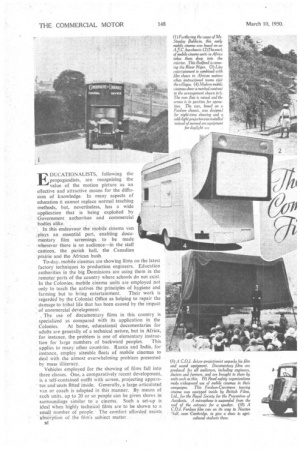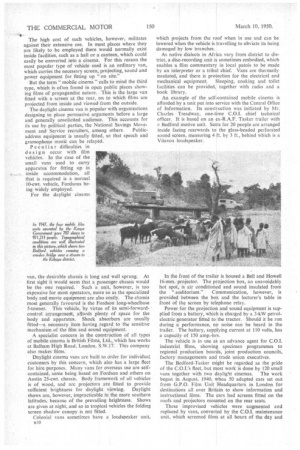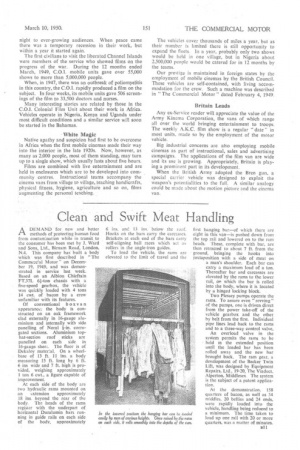-F4 DUCATION A LISTS, following the propagandists, are recognizing the
Page 42

Page 44

Page 45

If you've noticed an error in this article please click here to report it so we can fix it.
value of the motion picture as an effective and attractive means for the diffusion of knowledge. In many aspects of education it cannot replace normal teaching methods, but, nevertheless, has a wide application that is being exploited by 'Government , authorities and commercial
bodies alike. . •
In this endeavour the Mobile cinema van :plays an essential part, enabling documentary film screenings to be made wherever there is an audience—in the staff canteen, the parish hall, the Canadian prairie and the African bush.
To-day, mobile cinemas are showing films on the latest factory techniques to production engineers.. Education authorities in the big Dominions are using them in the remoter parts of the country where schools do not exist. In the Colonies, mobile cinema units are employed not only to teach the natives the principles of hygiene and farming but to bring entertainment. Their work is regarded by the Colonial Office as helping to repair the damage to tribal life that has been caused by the impact , of commercial development.
, The use of documentary films in this country is specialized as compared with its application in the Colonies. At home, educational documentaries for adults are generally of a technical nature, but in Africa, for instance, the problem is one of elementary instruc tion for large numbers of backward peoples. This . applies to many other countries. Russia and India, for instance, employ sizeable fleets of mobile cinemas to deal with the almost overwhelming problem presented by mass illiteracy.
Vehicles employed for the showing of films fall into three classes. One, a comparatively recent development, is a self-contained outfit with screen, projecting apparatus and•seats fitted inside. Generally, a large articulated van or coach is adapted in this manner. By means of such units, up to 26 or so people can be given shows in surroundings similar to a cinema. Such a set-up is ideal when highly technical films are to be shown to a small number of people. • The comfort afforded assists absorption of the film's subject matter. The high cost of such vehicles, however, militates against their extensive use. In most places where they are likely to be employed there would normally exist inside facilities, such as a hall or a canteen, which could easily be converted into a cinema. For this reason the most popular type of vehicle used is an ordinary van, which carries the necessary screen, projecting, sound and power equipment for fitting up "on site." But the term "mobile cinema" calls to mind the third type, which is often found in open public places showing films of propagandist nature. This is the large van fitted with a screen at the rear, on to which films are projected from inside and viewedfrom the outside. The daylight cinema van is popular with organizations designing to place persuasive arguments before a large and generally unsolicited audience. This accounts for its use by political parties, the National Savings Move ment and Service recruiters, among others. Public address equipment is usually fitted, so that speech and gramophone music can be relayed.
Peculiar difficulties in design occur with film vehicles. In the case of the small vans used to carry apparatus for fitting up in inside accommodation, all that is required is a normal 10-cwt. vehicle, Fordsons being widely employed.
For the daylight cinema van, the desirable chassis is long and well sprung. At first sight it would seem that a passenger chassis would be the one required. Such a unit, however, is too expensive for most operators, more so as the specialized body and movie equipment arc also costly. The chassis most generally favoured is the Fordson long-wheelbase 5-tanner. This vehicle, by virtue of its semi-forwardcontrol arrangement, affords plenty of space for the body and apparatus. Shock absorbers are usually fitted—a necessary item having regard to the sensitive mechanism of the film and sound equipment.
A specialist concern in the construction of all types of mobile cinema is British Films, Ltd., which has works at Balham High Road, London. S.W.17. This company also makes films.
Daylight cinema vans are built to order for individual customers by this concern, which also has a large fleet for hire purposes. Many vans for overseas use are selfcontained, some being based on Fordson and others on Austin 25-cwt. chassis. Body framework of all vehicles is of wood, and arc projectors are fitted to provide sufficient brightness for daylight viewing. Daylight shows are, however, impracticable in the more southern latitudes, because of the prevailing brightness. Shows are given at night, and so in tropical vehicles the folding screen shadow canopy is not fitted.
Colonial vans sometimes have a loudspeaker unit,
1310
which projects from the roof when in use and can be lowered when the vehicle is travelling to obviate its being damaged by low branches.
As native dialects in Africa vary from district to district, a disc-recording unit is sometimes embodied, which enables a film commentary in local patois to be made by an interpreter or a tribal chief. Vans are thermally insulated, and there is protection for the electrical and mechanical equipment. Sleeping, cooking and toilet facilities can be provided, together with radio and a book library.
An example of the self-contained mobile cinema is afforded by a unit put into service with the Central Office of Information. Its construction was initiated by Mr. Charles Treadway, one-time C.O.I. chief technical officer. It is based on an ex-R.A.F. Tasker trailer with Bedford motive unit. Seats for 20 people are arranged inside facing rearwards to the glass-beaded perforated sound screen, measuring 4 ft. by 3 ft., behind which is a Vitavox loudspeaker.
In the front of the trailer is housed a Bell and Howell 16-mm. projector. The projection box, an unavoidably hot spot, is air conditioned and sound insulated from the "auditorium." Communication, however, is provided between the box and the lecturer's table in front of the screen by telephone relay.
Power for the projection and sound equipment is supplied from a battery, which is charged by a 3-kW petrolelectric generator fitted to the tractor. Should it be run during a performance, no noise can be heard in the trailer. The battery, supplying current at 110 volts, has a capacity of 150 amp.-hrs.
The vehicle is in use as an advance agent for C.O.I. industrial films, showing specimen programmes to regional production boards, joint production councils, factory managements and trade union executives.
The Bedford-Tasker might be regarded as the pride of the C.O.I.'s fleet, but most work is done by 120 small vans together with two daylight cinemas. The work began in August, 1940, when 50 adapted cars set out from G.P.O. Film Unit Headquarters in London for destinations all over Britain to show information and instructional films. The cars had screens fitted on the roofs and projectors mounted on the rear seats.
These improvised vehicles were augmented and replaced by vans, converted by the C.O.I. maintenance unit, which screened films at all hours of the day and night to ever-growing audiences. When peace came there was a temporary recession in their work, but within a year it started again.
The first civilians to visit the liberated Channel Islands were members of the service who showed films on the progress of the war. During the 12 months ended March, 1949, C.O.I. mobile units gave over 55,000 shows to more than 5,000,000 people.
When, in 1947, there was an outbreak of poliomyelitis in this country, the C.O.I. rapidly produced a film on the subject. In four weeks, its mobile units gave 506 screenings of the film to 33,500 doctors and nurses.
Many interesting stories are related by those in the C.O.I. Colonial Film Unit about their work in Africa. Vehicles operate in Nigeria, Kenya and Uganda under most difficult conditions and a similar service will soon be started in the Bahamas.
White Magic
Native apathy and suspicion had first to be overcome in Africa when the first mobile cinemas made their way into the interior in the late 1920s. Now, however, as many as 2,000 people, most of them standing, may turn up to a single show, which usually lasts about five hours.
Films are combined with live entertainment and are held in enclosures which are to be developed into community centres. Instructional teams accompany the cinema vans from village to village, teaching handicrafts, physical fitness, hygiene, agriculture and so on, films augmenting the personal teaching. The vehicles cover thousands of miles a year, but as their number is limited there is still opportunity to expand the fleets. In a year, probably only two shows would be held in one village, but in Nigeria about 2,500,000 people would be catered for in 12 months by the teams.
Our prestige is maintained in foreign states by the employment of mobile cinemas by the British Council. These vehicles are self-contained, with living accommodation for the crew. Such a machine was described in "The Commercial Motor" dated February 4, 1949.
Any ex-Service reader will appreciate the value of the Army Kinema Corporation, the vans of which range all over the world bringing entertainment to troops. The weekly A.K.C. film show is a regular " date " in most units, made so by the employment of the motor vehicle.
Big industrial concerns are also employing mobile cinemas as part of instructional, sales and advertising campaigns. The applications of the film van are wide and its use is growing. Appropriately, Britain is playing a prominent part in its development.
When the British Army adopted the Bren gun, a special carrier vehicle was designed to exploit the weapon's potentialities to the full. A similar analogy could be made about the motion picture and the cinema van.




















































































